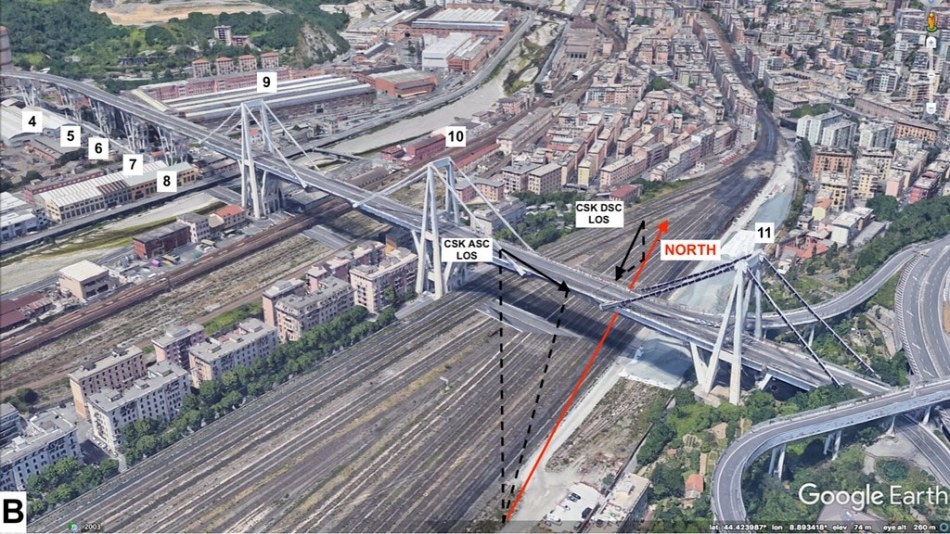Jul 10 2019
Merging data from a new generation of satellites with an advanced algorithm, a new monitoring system put together by scientists at the University of Bath with NASA could be used by developers or governments to serve as a warning system ensuring important infrastructure projects are safe.
 The Morandi Bridge before its collapse. New satellite radar imaging can show the movement of structures with millimeter accuracy. (Image credit: Remote Sensing)
The Morandi Bridge before its collapse. New satellite radar imaging can show the movement of structures with millimeter accuracy. (Image credit: Remote Sensing)
A team of experts guided by NASA’s JPL and engineers from Bath confirmed the method by reviewing 15 years of satellite imagery of the Morandi Bridge in Genoa, Italy, a portion of which collapsed in August 2018 killing 43 people. The review, published in the journal Remote Sensing, exposed that the bridge did indicate signs of warping in the months before the disaster.
Dr Giorgia Giardina, Lecturer in the University’s Department of Architecture and Civil Engineering, said: “The state of the bridge has been reported on before, but using the satellite information we can see for the first time the deformation that preceded the collapse. We have proved that it is possible to use this tool, specifically the combination of different data from satellites, with a mathematical model, to detect the early signs of collapse or deformation.”
While present structural monitoring methods can spot signs of movement in a building or bridge, they concentrate only on particular points where sensors are positioned. The new method can be used for near-real time monitoring of a complete structure.
The technique marks an improvement over traditional methods because it allows scientists to gauge changes in ground deformation across a single infrastructure with unprecedented frequency and accuracy.
Dr Pietro Milillo, Study Lead author, Jet Propulsion Laboratory
Dr Milillo continued, "This is about developing a new technique that can assist in the characterisation of the health of bridges and other infrastructure. We couldn't have forecasted this particular collapse because standard assessment techniques available at the time couldn't detect what we can see now. But going forward, this technique, combined with techniques already in use, has the potential to do a lot of good."
This is made viable by the progress in satellite technology, specifically on the joint use of the Italian Space Agency’s (ASI) COSMO-SkyMed constellation and the European Space Agency's (ESA's) Sentinel-1a and 1b satellites, which enables more accurate data to be collected. Precise Synthetic Aperture Radar (SAR) data, when collected from many satellites pointed at various angles, can be used to construct a 3D picture of a building, bridge, or city street.
Dr Giardina stated, “Previously the satellites we tried to use for this research could create radar imagery accurate to within about a centimetre. Now we can use data that is accurate to within a millimetre—and possibly even better, if the conditions are right. The difference is like switching to an Ultra-HD TV—we now have the level of detail needed to monitor structures effectively.”
There is clearly the potential for this to be applied continuously on large structures. The tools for this are cheap compared to traditional monitoring and can be more extensive. Normally you need to install sensors at specific points within a building, but this method can monitor many points at one time.
Dr Giorgia Giardina, Lecturer, Department of Architecture and Civil Engineering, University of Bath
The method can also be used to monitor the movement of structures when underground excavations, such as tunnel boring, are carried out.
We monitored the displacement of buildings in London above the Crossrail route. During underground projects there is often a lot of data captured at the ground level, while fewer measurements of structures are available. Our technique could provide an extra layer of information and confirm whether everything is going to plan.
Dr Giorgia Giardina, Lecturer, Department of Architecture and Civil Engineering, University of Bath
Infrastructure organizations in the United Kingdom have already approached Dr Giardina with a plan to setting up monitoring of rail networks and roads.